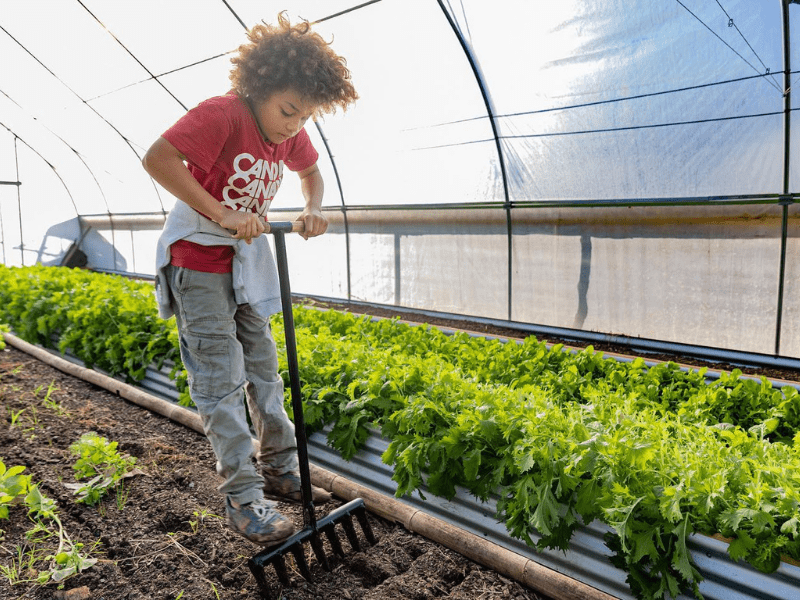Spring Planting in a Polytunnel: What to Grow Right Now in Australia
Spring in Australia is a time of transformation. Days grow longer, the chill of winter fades, and gardens everywhere begin to burst back into life. For those with a polytunnel, this is a season of opportunity—the chance to start warm-weather crops early, maintain steady harvests, and protect delicate seedlings from the unpredictability of spring weather. But the real question for growers, whether backyard gardeners or small-scale farmers, is this: what should you plant right now in your polytunnel to get the most out of the season?
In this guide, we’ll take a deep dive into the crops that thrive in tunnels during spring, how to prepare your soil and manage irrigation, and why succession planting is the key to abundant harvests. Along the way, we’ll share practical, experience-based tips to help you make this spring your most productive yet.
Why Spring is the perfect time to maximise your tunnel
Spring provides growers with the perfect balance of conditions. The risk of frost is fading, daylight hours are increasing, and soil begins to warm. Yet spring can also bring unpredictable rain, gusty winds, and sudden cold snaps. This is where your polytunnel comes into its own.
By creating a protected microclimate, your tunnel shields plants from erratic weather while maintaining warmth and consistent soil conditions. This means:
Seedling protection, giving them the best start in life for maximum success.
Earlier planting of warm-season crops like tomatoes and cucumbers.
Steadier growth for tender crops that might otherwise struggle outdoors.
Extended productivity, as you can overlap cool-season and warm-season crops.
Spring is also the season when pests and diseases begin to re-emerge, making the controlled environment of a tunnel even more valuable.
We talk more about season extension in our blog article ‘Grow Year Round: Season extension in a polytunnel’.
Benefits of using a polytunnel in Australian spring
If you’re yet to experience the benefit of growing in a polytunnel, then you’re in for a real treat this spring. Not only can you be gardening and tending to your crops, rain, hail or shine – your crops are also going to see some benefits from the warmer environment of your GROW Tunnel. Here’s just a few of the benefits a polytunnel has to offer spring gardeners:
Extended Growing Season: Start your seedlings earlier, and get crops planted sooner than in open air gardens.
Increased Yield: Protect crops from pests and fluctuating weather.
Greater Variety: Grow crops that might struggle outdoors, like cucumbers or melons.
Controlled Environment: Better soil, moisture, and temperature management.
Want to explore more benefits? Read our blog ‘Benefits of growing in a polytunnel.’
Preparing your tunnel for spring success
Before diving into planting, set your tunnel up for success. Start by refreshing your soil with compost or well-rotted manure to replenish nutrients lost over winter. Good soil preparation is the foundation of strong, healthy crops. Test your soil pH if you can—most vegetables thrive around neutral, though leafy greens can tolerate slightly acidic conditions.
Moisture management is another spring priority. As the weather warms, tunnels can dry out quickly. Installing drip irrigation is one of the most efficient ways to keep soil moisture steady, and pairing it with mulch helps reduce evaporation. If you’ve installed a guttering system, now is the time to make sure rainwater collection is set up and ready for the dry months ahead. The turn of the season is a good reminder to clean out your gutters, so you’re capturing as much usable water as possible.
Finally, check your ventilation. As the sun strengthens, overheating can stress young plants. Make use of roll-up sides, internal shading, or insect netting to create airflow while keeping pests out.
What to plant in your tunnel this spring
Leafy Greens for Early Harvests
Leafy greens are a reliable choice for spring. They thrive in mild weather, grow quickly, and can be harvested in as little as four to six weeks. In tunnels, they are protected from pests like caterpillars and birds, ensuring cleaner, higher-quality leaves.
Lettuce varieties such as cos and butterhead provide both cut-and-come-again leaves and full heads.
Spinach is fast to germinate and performs well in early spring before the heat intensifies.
Rocket offers a peppery kick and matures quickly for continuous picking.
Kale provides hardy greens and can keep producing well into summer if regularly harvested.
Herbs to Complement Your Crops
Fresh herbs add both flavour and profitability to your tunnel. If you’re growing to feed your family, herbs are an absolute must. No more rotting herbs at the back of the fridge for you! Spring is the ideal time to plant:
Parsley and coriander, which thrive before the peak summer heat.
Basil, which benefits from the warmer microclimate of a tunnel and can be succession-planted for months of harvest.
Chives and mint, hardy perennials that offer reliable spring growth.
Root Vegetables for Steady Production
Root crops are often overlooked for tunnel growing, but spring is a great time to get them started.
Carrots develop straighter roots in loose, well-prepared soil.
Radishes are ready to harvest within 3-4 weeks, making them an excellent filler crop between slower growers.
Beetroot offers deep red roots, good for the liver and edible leaves.
Warm-Weather Crops You Can Start Early
One of the biggest spring advantages of polytunnels is the ability to bring forward warm-season planting.
Tomatoes are the classic tunnel crop. They need warmth to germinate and grow, and tunnels protect them from spring chills. With proper pruning and training, they’ll deliver heavy yields throughout summer.
Tunnel conditions protect against cold snaps.
Choose indeterminate varieties for long harvests.
Start seeds in trays, then transplant to tunnel beds.
Cucumbers climb well on vertical supports inside tunnels, saving space while providing steady harvests.
Grow quickly in the tunnel’s warmth.
Train vertically to save space.
Capsicums and chillies can be slow to get going outdoors, but tunnels give them the early boost they need.
Need extra warmth in early stages.
Tunnels provide the protection they need to get established.
Melons, especially smaller-fruited varieties, thrive in tunnel warmth and reward patient growers with sweet summer harvests.
Typically tricky outdoors, but tunnels give them the head start they need.
Choose small-fruited varieties for quicker maturity.
Pumpkins grow well inside polytunnels, however if you don’t wish to use up all your space, dedicate part of your tunnel to seedling raising, giving your pumpkin seeds the best start in life and transplant to outdoor beds when they’ve grown to a hardy size.
Benefit from the warmth of the tunnel, enabling earlier seeding.
Do well outside once the weather warms up, so transplant when temperatures begin to rise.
Spring & Edible Flowers not only add a beautiful burst of colour to your tunnel, they can attract pollinators and work as great companion plants, keeping certain pests at bay.
Plant in pots for transplanting outside in the warmer months.
Tunnels can protect flowers from being damaged from wind and rain.
Nasturtiums, marigolds, calendula, and violas all offer great pest protection properties and are edible too.
The Power of Succession Planting for Continuous Harvests
One of the most effective ways to keep your tunnel productive through spring and summer is succession planting—sowing smaller amounts of crops at regular intervals. Instead of planting an entire bed of lettuce at once, for example, sow a few rows every fortnight. This prevents gluts, reduces waste, and ensures a steady stream of fresh produce.
Radishes are particularly well-suited to succession planting, as they grow quickly and can slot into spaces between slower crops. Salad mixes, beans, and herbs also benefit from staggered sowing. By layering your planting schedule, you can maximise both yield and tunnel space.
Spring is the time to plan succession planting so you never run out of fresh produce. This means sowing small amounts of crops every 2–3 weeks.
Lettuce & salad mixes: Plant fortnightly for a steady supply.
Radishes: Sow every 10–14 days.
Beans & peas: Stagger planting to avoid gluts.
This ensures your polytunnel stays productive throughout spring and into summer.
Common Spring Challenges: Pests and Diseases
While tunnels offer protection, they aren’t pest-proof. In fact, the sheltered environment can sometimes create conditions where pests thrive if not managed properly.
Aphids often appear as temperatures rise. Regular monitoring and introducing beneficial insects like ladybirds can help keep populations under control.
Cabbage white butterflies can quickly become a nuisance in warm tunnels—squishing caterpillars or using an organic spray like Dipel controls them.
Slugs and snails may sneak in after rain, particularly if mulch is too thick.
Powdery mildew becomes a risk as humidity builds. Proper spacing, ventilation, and watering at the base of plants (rather than overhead) will help reduce outbreaks.
Rodents mice in particular are looking for a warm cosy spot and love to eat seed, so make sure to keep your seedling trays covered until germinated and use mouse traps if necessary
By keeping a close eye on your crops and taking action early, you can avoid losing precious plants to common spring problems.
Integrated pest management is key: combine good airflow, healthy soil, and companion planting to reduce risk. If necessary use an organic pest spray, to keep bugs at bay.
Soil Prep and Irrigation Tips for Spring
Soil Preparation
Add compost or well-rotted manure to boost fertility.
Test soil pH and adjust if necessary.
Mulch to retain moisture and suppress weeds.
Irrigation
Spring weather can be unpredictable—installing drip irrigation in tunnels helps maintain consistency.
Water early in the day to prevent humidity-related diseases.
Use rainwater collection from gutters to reduce reliance on mains supply.
A Month-by-Month Polytunnel Planting Guide (Aug–Nov)
August: Focus on cool-loving crops like spinach, kale, lettuce, radishes, parsley and coriander. Start tomato, capsicum, pumpkin and melon seedlings in trays inside the tunnel.
September: Begin transplanting tomatoes, cucumbers. Move melons and pumpkins outside towards the end of the month. Keep leafy and asian green seedlings growing for continuous harvest. Start eggplant, corn and capsicum seedlings.
October: As temperatures climb, plant capsicums, chillies, rocket, and beans. Continue succession planting of salad greens, tomatoes and cucumbers.
November: Keep planting quick growers like lettuce and basil. Add zucchini or later tomato sowings to extend your harvest window into summer.
Making the Most of Spring in Your Tunnel
Spring is more than just a new season—it’s the foundation for your year’s harvest. By planting strategically, maintaining soil health, and planning ahead with succession planting, you set yourself up for abundance well into summer. With a polytunnel, you’re not at the mercy of the weather. Instead, you can shape the environment to suit your crops, protecting delicate seedlings and encouraging strong, early growth.
Whether you’re aiming for fresh family salads, baskets of ripe tomatoes, or the challenge of melons and cut flowers, your tunnel is the ultimate springboard into the growing year. Now is the time to prepare, plant, and nurture—and to enjoy the satisfaction of watching your tunnel transform into a thriving hub of life and productivity.






